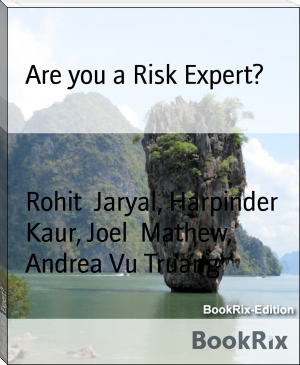Are you a Risk Expert? by Rohit Jaryal, Harpinder Kaur, Joel Mathew, Andrea Vu Truang (top fiction books of all time txt) 📖

- Author: Rohit Jaryal, Harpinder Kaur, Joel Mathew, Andrea Vu Truang
Book online «Are you a Risk Expert? by Rohit Jaryal, Harpinder Kaur, Joel Mathew, Andrea Vu Truang (top fiction books of all time txt) 📖». Author Rohit Jaryal, Harpinder Kaur, Joel Mathew, Andrea Vu Truang
ARE YOU A RISK EXPERT?
A GUIDE
SUBMITTED TO THE
LAMBTON COLLEGE, SARNIA, ON
FOR THE FULFIMENT OF THE REQUIREMENTS
FOR THE
COURSE OF MANAGING STRESS AND CONFLICTS
IN PROJECT MANAGEMENT
Supervisor Submitted by
Ms. Karen Minty Harpinder Kaur
Andrea Vu Truong
Joel Mathew
Rohit Jaryal
11 April, 2020
DECLARATION
We hereby affirm that the work presented in guide entitled “Are You a Risk Expert” submitted to the Lambton college, Sarnia, ON in partial fulfilment of the requirements for the grades of course managing stress and conflicts is an authentic record of our personal research work.
(Group 5)
Table of Contents
Table of Contents
DECLARATION.. 2
Chapter 1: Introduction. 5
Objectives of Risk Management 5 Risk Types. 6 Strategy of risk management 6 History of Risk Management 6 Motive of Risk management 7Chapter 2: Risk Perceptions in Other Segments. 10
What is a hedge fund?. 10
Hedge funds’ downsides – Risks. 10
Hedge funds’ rewards: The real story. 10
Banking – The Three Major Risks. 11
Credit risk. 11
Operation risk. 11
Market risk. 11
Chapter 3: Identify the Risks. 13
Identification of Risks Can Be Done Through. 13
Chapter 4: Risk Tolerance. 14
Risk tolerance: Avoid or Accept?. 14
Chapter 5: Prioritizing the Risks. 15
Risk Impact assessment 15 Purpose of risk assessment- 16 Importance of Risk assessment 16 Method of risk assessment 16 Risk Metrics. 17 Implementation of Risk Metrics. 18 Probability of Risks. 18Chapter 6: Managing Risks. 20
Managing Risks. 201.1 Identifying risk. 20
1.2 Categorizing risk. 20
1.3 Evaluate risk. 20
1.4 Dealing with risk. 20
1.5 Re-evaluation of risk. 21
Minimize the Risks. 21 Taking Insurance. 213.1 Implementing risk protection strategies. 22
3.2 Having huge capital as a reserve. 22
3.3 Hiring experts related to the issue. 22
Identify Risk Triggers. 22 Consider Threats and Opportunities. 22 Strategy to Reduce the Risks. 236.1 Risk avoidance. 23
6.2 Risk acceptance. 23
6.3 Risk partial acceptance. 23
6.4 Risk transference. 23
Conclusion. 24
Reference. 25
Chapter 1: Introduction
Every business whether it’s global or local faces the risk of unexpected events that could affect the organization financially or may close it permanently. That’s where Risk management comes into play. Risk management is the process of identifying and controlling threats to maximize the profits and minimizing the loss or uncertainties. Risks can be from numerous assets inclusive of uncertainty in economic markets, legal liabilities, credit threat, injuries, disasters, deliberate assault from an adversary, or events of unsure or unpredictable outcome.


Figure 1: An Illustration of Risk Management
There are two types of risk. Negative risks may be categorized as dangers and positive events are categorized as opportunities. Risk control standards have been developed by means of numerous establishments, along with the Project Management Institute, the National Institute of Standards and Technology, actuarial societies, and ISO requirements.
Objectives of Risk ManagementMain objectives of risk management concerns the protection and strengthening of:-
1. Growth of organizational culture
2. Leadership and relationship
3. Effectiveness and efficiency of processes
4. Stakeholder satisfaction
Risk management is an ongoing process that keeps ongoing through the whole process.
Risk TypesBusiness Risk- These types of risks are taken by organizations themselves whenever they must launch a product in the market. It is a high risk but the goal behind this is to gain maximum profits later.
Non business risks- These risks do not come under any organization or category. Whereas, these arises because of political or economic issues.
Financial Risk These risks come in financial category. These risks consist of losses to financial firms because of fluctuation in stock markets, currency rates and interest rates. Financial risks are subdivided to:
Market risk
Credit Risk
Liquidity Risk
Operational Risk
Legal Risk
Strategy of risk managementIdentification of threats
Accessing vulnerability of assets to specific threats
Determining the likelihood of various risks and consequences
Identifying ways to mitigate those risks
Prioritizing risk reducing measures
History of Risk ManagementStudy of risk management started after world war two. Modern risk management started after 1955. From a long time, risk management has been associated with market insurance which used to protect people and companies from any losing related with accidents. Other alternatives came to light in 1950’s when market insurance was considered as very costly. International risk regulation started in 1980’s. first two books published on Risk management were by Mehr and hedges (1963) and Williams and hems (1964). It was found that there were no books on risk management at that time. In 1980, internal risk management models were built by the financial institutions to save them from unexpected uncertainties. Those were the times when control of risk management became essential and integrated risk management was introduced along with creating position of Chief risk officer (CRO). Except the risk management, one of the tools risk assessment was first introduced legally in 1992 within the regulations. The regulations were formed so that all the owners must access the risks so that in no way they could do any harm to people or business. So, the risk assessment process was systematic and logical.
Motive of Risk managementRisk management allows us to identify the trouble spots easily. Risk management practices and processes helps us in advance to identify any





Comments (0)